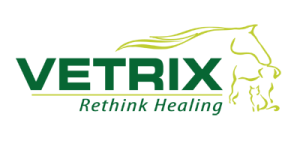At Vetrix, our main goal is to help you provide the best possible care for your patients—which includes not only the latest technology in regenerative medicine, but also helpful resources for you and your practice. Keep reading for a breakdown of our Quick Guide to Corneal Ulcers, created with Dr. Shelby Reinstein.
A Super Simple Guide to Corneal Ulcers
When it comes to corneal ulcers in animals, there are five important steps you need to remember: classify, cause, treat, heal, and recheck. Now, we’ll break down each step into specific actions.
Classify
The first step, of course, is to examine your patient’s eye. You’re checking to see if the corneal ulcer is simple or complicated. “Simple” refers to a few different key characteristics:
- Superficial;
- No evidence of infection;
- Heals quickly;
- No scar formation;
- No neovascularization or corneal melting.
In general, a “complicated” corneal ulcer will have one or more of the above things present, including the threat of vision loss or permanent damage to the eye.
Cause
Once you’ve classified your patient’s corneal ulcer as simple or complicated, it’s time to determine the cause. Your case will fall into one of three cause categories: mechanical, primary corneal disease, or infectious. Each of these main categories are then broken down further into specific causes. For example, some potential mechanical causes include a bite injury, an eyelid mass, and distichia.
Treat
Once you’ve determined the cause, it’s time to create a treatment plan. For a simple corneal ulcer, common treatment options include prescribing a broad-spectrum drop or ointment, an oral anti-inflammatory, and some additional pain control. For a complicated corneal ulcer, however, your treatment plan will include a lot more.
Heal
When it comes to healing a corneal ulcer, the products you use matter. You’ll want something that will enhance the growth of corneal epithelial cells, reduce corneal scar formation, and provide long-lasting lubrication. That’s where Vetrix EyeQ Amniotic Eye Drops come in. They contain anti-inflammatory components to aid traditional treatments.
Recheck
Rechecking is a crucial part of any treatment plan—after all, you’re treating a living thing, not a machine. Make sure you’re carefully monitoring your patient’s progress and adjusting their plan as needed!
Looking to Better Your Veterinary Practice?
Vetrix is the leading provider of veterinary regenerative medicine. Our technologies harness the natural capabilities of your patients’ existing cells for more efficient, natural healing. If you’re interested in learning more about our product, feel free to reach out! We look forward to hearing from you and answering your questions.








